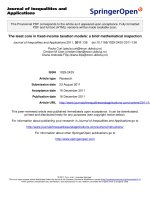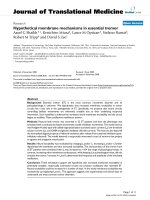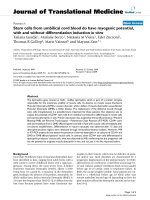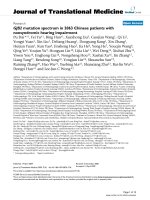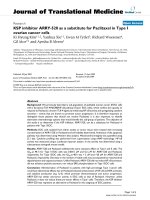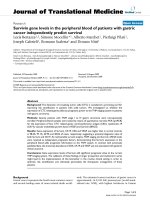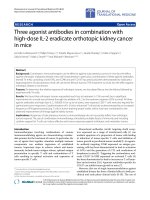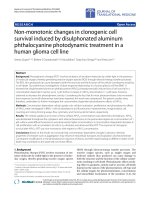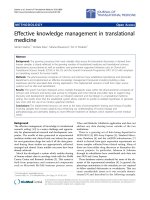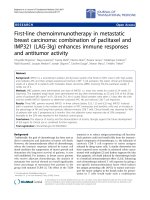Báo cáo hóa học: " Crimean-Congo Haemorrhagic Fever in Kosova : a fatal case report" pot
Bạn đang xem bản rút gọn của tài liệu. Xem và tải ngay bản đầy đủ của tài liệu tại đây (209.8 KB, 4 trang )
BioMed Central
Page 1 of 4
(page number not for citation purposes)
Virology Journal
Open Access
Case Report
Crimean-Congo Haemorrhagic Fever in Kosova : a fatal case report
Salih Ahmeti
1
and Lul Raka*
2
Address:
1
Infectious Disease Clinic, University Clinical Centre of Kosova & Faculty of Medicine, Prishtina University, Rrethi i spitalit, p.n., 10 000
Prishtina, Kosova and
2
Department of Microbiology, National Institute of Public Health of Kosova & Faculty of Medicine, Prishtina University,
Rrethi ispitalit, p.n., 10 000 Prishtina, Kosova
Email: Salih Ahmeti - ; Lul Raka* -
* Corresponding author
Abstract
Crimean-Congo haemorrhagic fever (CCHF) is an often fatal viral infection described in about 30
countries around the world. The authors report a fatal case of Crimean-Congo hemorrhagic fever
(CCHF) observed in a patient from Kosova. The diagnosis of CCHF was confirmed by reverse
transcription-PCR. Late diagnosis decreased the efficacy of treatment and patient died due to
severe complications of infection.
Background
Crimean-Congo haemorrhagic fever (CCHF) is a tick-
born disease caused by a Nairovirus of the Family Bunya-
viridae. Infection is transmitted to humans by Hyalomma
ticks or by direct contact with the blood or tissues of
infected humans or viraemic livestock [1,2]. Clinical fea-
tures usually include a rapid progression characterised by
haemorrhage, myalgia and fever, with a mortality rate of
up to 30%. CCHF virus has a wide geographic distribu-
tion, circulating in Africa, the Middle East, Asia, and Cen-
tral and South-Eastern Europe [3]. CCHF was first
clinically described in 1944 in Crimea in the former Soviet
Union during a large outbreak of over 200 cases [4].
CCHF virus was identified in 1967, from a patient in
Uzbekistan, and was found to be similar to a virus isolated
in 1956 in Congo, hence the name Crimean-Congo [5,6].
The Balkan Peninsula is an endemic region for the disease,
sporadic cases or even outbreaks being observed every
year. The first case in Kosova occurred in 1954 [7]. There
were no registered cases of CCHF in Kosova until 1989(7
cases). Three outbreaks occurred in 1995, 2001 and 2004
with, overall, 186 serologically confirmed cases of the dis-
ease, with a case fatality rate of 27% [8]. There were also a
large number of patients who presented with clinical fea-
tures of haemorrhagic fever, but confirmatory serological
diagnosis was not available due to technical reasons. Kos-
ova is also known as an endemic region for hemorrhagic
fever with renal syndrome (HFRS) caused by hantaviruses,
which can coexist with CCHF viruses.
Case presentation
A previously healthy 8-year-old boy, living in the village
Carallukë near Prishtina, Kosova, at the end of May 2004,
was caring for livestock in the meadow and bathing in a
nearby stream for three consecutive days. His father
recalled that the boy had removed a tick from his head
about five days before the onset of the disease.
The disease started on 27 May, with chills, myalgia, cough,
nausea, anorexia, vomiting, headache and backache. On
28 May, the patient visited the family doctor in an outpa-
tient clinic and received ambulatory care (antibiotics, cor-
ticosteroids and antipyretics). On May 29, he visited a
pediatrician in a private outpatient clinic in the regional
health care centre in Prizren, where broad-range antibiotic
Published: 12 October 2006
Virology Journal 2006, 3:85 doi:10.1186/1743-422X-3-85
Received: 06 June 2006
Accepted: 12 October 2006
This article is available from: />© 2006 Ahmeti and Raka; licensee BioMed Central Ltd.
This is an Open Access article distributed under the terms of the Creative Commons Attribution License ( />),
which permits unrestricted use, distribution, and reproduction in any medium, provided the original work is properly cited.
Virology Journal 2006, 3:85 />Page 2 of 4
(page number not for citation purposes)
therapy was initiated. The doctor recommended hospital-
ization in case of non-response to therapy, since the
patient came from an area in which CCHF was endemic.
On 31 May, the patient was admitted to the Pediatric
Clinic at the University Clinical Centre of Kosova, the
only tertiary care center for an estimated 2.1 million
inhabitants of Kosova. On admission to the clinic, the
patient presented with chills, cough, vomiting, headache,
backache and pain in both legs.
On initial examination, his vital signs included a body
temperature of 40°C, a pulse of 106 beats/min and a res-
piratory rate of 40 breaths/min. The patient was orien-
tated, without neurological symptoms, but prostrate.
The patient was anaemic with an erythrocyte count and
hemoglobin level of 3.4 × 10
12
cells/litre (normal range,
4.5 × 10
12
- 5.9 × 10
12
cells/litre) and 11.5 g/dl (normal
range, 13.5 – 17.5 g/dl), respectively. Thrombocytopenia
was noted, with a platelet count of 59.2 × 10
9
/litre (nor-
mal range, 140 × 10
9
- 400 × 10
9
/litre). Mild hyperbiliru-
binemia, hypoproteinemia, and hypoalbuminemia were
also present. The patient was treated with intravenous
antibiotics, corticosteroids and antipyretics according to
presenting sepsis syndrome and lack of haemorrhagic syn-
drome in admission to tertiary care center. However, the
symptoms did not improve and the patient was not recov-
ering. Moreover, despite a decrease in temperature to
38°C on 2 June, the boy developed epistaxis and gingival
bleeding. He was anxious and this was accompanied by
uncontrolled screaming. Next day, he was transferred to
the Infectious Disease Clinic in a serious condition, not
fully conscious, and with diffuse haemorrhagic signs
appearing, with purpuric lesions on the trunk and face,
and with gingival bleeding. Large ecchymoses appeared at
the sites of venepuncture.
The heart was in sinus rhythm: 110 beats/min with weak
pulse tone. The abdomen was tender on palpation and the
liver and spleen were both palpable. Meningeal signs were
slightly positive. Abdominal ultrasonography revealed
hepatosplenomegaly and the presence of free liquid in the
abdominal cavity, suggestive of hemoperitoneum. Fifty
ml of blood was withdrawn from the abdominal cavity by
paracentesis. Lumbar puncture revealed clear cerebrospi-
nal fluid without increase in cellular elements.
On 4 and 5 June, the patient developed massive hemor-
rhage with hematemesis, melena, and petechiae. Epistaxis
continued and nasal tamponade was undertaken.
The erythrocyte count and hemoglobin level decreased
from 3.4 to 2.9 × 10
12
cells/litre and from 11.5 to 10.8 g/
dl, respectively. An infusion of fresh platelets partially cor-
rected the thrombocytopenia, and the count increased
from 59.2 to 96.3, but this later decreased again to 64 ×
10
9
/litre.
The alanine transaminase and lactate dehydrogenase lev-
els were 164 U/litre (normal range, 5 to 40 U/litre) and
287 U/liter (normal range, 114 to 240 U/litre), respec-
tively, suggesting liver dysfunction. Activated partial
thromboplastin time was 110 seconds(= 60 seconds) and
the fibrinogen level was 80 mg/dL(normal value = 110
mg/dL). Coagulation factors (II, V, VII, X) were decreased.
Serological tests for hepatitis were negative.
Supportive therapy given to the patient during the course
of the disease consisted of hydration, antibiotics and con-
trol of temperature. Blood transfusions, two plasma and
three platelets solutions were administered to the patient.
Ribavirin was not administered because it was not availa-
ble and the patient had already had a week with symp-
toms. Despite the treatment, the clinical features
deteriorated and the patient died on 6 June due to haem-
orrhagic shock and pulmonary oedema.
The blood samples drawn on 3 June for serological and
molecular testing were referred to the WHO Collaborating
Centre for Arbovirus and Haemorrhagic Fever Reference
and Research in Ljubljana, Slovenia. This centre provides
laboratory support for the CCHF in Kosova. ELISA tests
for CCHF and Hantan-virus were negative in the serum
sample, whereas the diagnosis of CCHF was confirmed by
reverse transcription-PCR from serum and blood
obtained during paracentesis.
Complete S segment of the Kosovo Hoti strain was con-
firmed in Slovenia [9]. It was deposited under the [Gen-
Bank : DQ133507
]. Phylogenetic studies have shown that
the Kosovan strain is grouped together in the clade with
the Southwest Russian and Turkish strains and is phyloge-
netically most closely related to Drosdov strain of CCHFV
[10].
Conclusion
From this report, the most important lesson to be derived
is that late diagnosis decreases the efficacy of treatment
and aggravates the outcome of the disease. Diagnosis of
CCHF is important to prevent the spread of CCHF virus
among the health-care workers and relatives of patients.
Treatment with ribavirin may be useful if given within the
early stage of disease [11]. The presence of visceral bleed-
ing is a predictor of poor prognosis. The other lesson to be
learned from this case is that every febrile haemorrhagic
syndrome encountered in endemic areas, such as parts of
Kosova, should probably be considered to be viral haem-
orrhagic fever, until proven otherwise.
Virology Journal 2006, 3:85 />Page 3 of 4
(page number not for citation purposes)
Competing interests
The author(s) declare that they have no competing inter-
ests
Authors' contributions
SA participated in acquisition, analysis and interpretation
of data. LR participated in the design of the study and
drafted the manuscript. Both authors read and approved
the final manuscript.
Acknowledgements
We thank Prof. MMH Sewell and Dr. Mary Packer for critical reading and
correction of manuscript.
References
1. Ergonul O: Crimean-Congo haemorrhagic fever. Lancet Infect
Dis 2006, 6:203-14.
2. Charrel RN, Attoui H, Butenko AM, Clegg JC, Deubel V, Frolova TV,
Gould EA, Gritsun TS, Heinz FX, Labuda M, Lashkevich VA, Loktev V,
Lundkvist A, Lvov DV, Mandl CW, Niedrig M, Papa A, Petrov VS, Ply-
usnin A, Randolph S, Süss J, Zlobin VI, de Lamballerie X: Tick born
virus diseases of human interest in Europe. Clin Micrbiol and
2004, 10:1040-1056.
3. Lindenbach BD, Rice CM, Chanock RM: Flaviviridae: the viruses
and their replication. In Fields virology 4th edition. Edited by:
Knippe DM, Howley PM, et al Philadelphia, PA:Lippincot, Williamd &
Willkins; 2001:991-1041.
4. Hoogstraal H: The epidemiology of tick born Crimean-Congo
haemorrhagic fever in Asia, Europe and Africa. J Med Entomol
1979, 15:307-417.
5. Casals J: Antigenic similarity between the virus causing
Crimean haemorrhagic fever and Congo virus. Proc Soc Exp
Biol Med 1969, 131:233-236.
Map of the South-East EuropeFigure 1
Map of the South-East Europe.
Publish with BioMed Central and every
scientist can read your work free of charge
"BioMed Central will be the most significant development for
disseminating the results of biomedical research in our lifetime."
Sir Paul Nurse, Cancer Research UK
Your research papers will be:
available free of charge to the entire biomedical community
peer reviewed and published immediately upon acceptance
cited in PubMed and archived on PubMed Central
yours — you keep the copyright
Submit your manuscript here:
/>BioMedcentral
Virology Journal 2006, 3:85 />Page 4 of 4
(page number not for citation purposes)
6. Whitehouse CA: Crimean-Congo haemorrhagic fever. Antivir
Res 2004, 64:145-160.
7. Vesenjak-Hirjan J, Punda-Polic V, Dobe M: Geographical distribu-
tion of arboviruses in Yugoslavia. J Hyg Epidemiol Microbiol Immu-
nol 1991, 35(2):129-40.
8. Humolli I: Karakteristikat epidemiologjike, serologjike dhe
përcaktimi i zonave endemike për Ethen Hemorragjike
Krime-Kongo në Kosovë 1995–2002. In Disertacion Universiteti i
Prishtinës, Fakulteti i Mjekësisë; 2003.
9. Duh D, Saksida A, Petrovec M, Dedushaj I, Avsic-Zupanc T: Novel
one-step real-time RT-PCR assay for rapid and specific of
Crimean-Congo hemorrhagic fever encountered in the Bal-
kans. J Virol Methods 2006, 133(2):175-9.
10. Drosten C, Minnak D, Emmerich P, Schmitz H, Reinicke T: Crimean-
Congo Haemorrhagic Fever in Kosovo. J Clin Microbiol 2002,
40:1122-1123.
11. Ergonul O, Celikbas A, Dokuzoguz B, Eren S, Baykam N, Esener H:
The characteristics of Crimean-Congo Hemorrhagic Fever
in a recent outbreak in Turkey and the impact of oral ribavi-
rin therapy. Clin Infect Dis 2004, 39:285-89.
